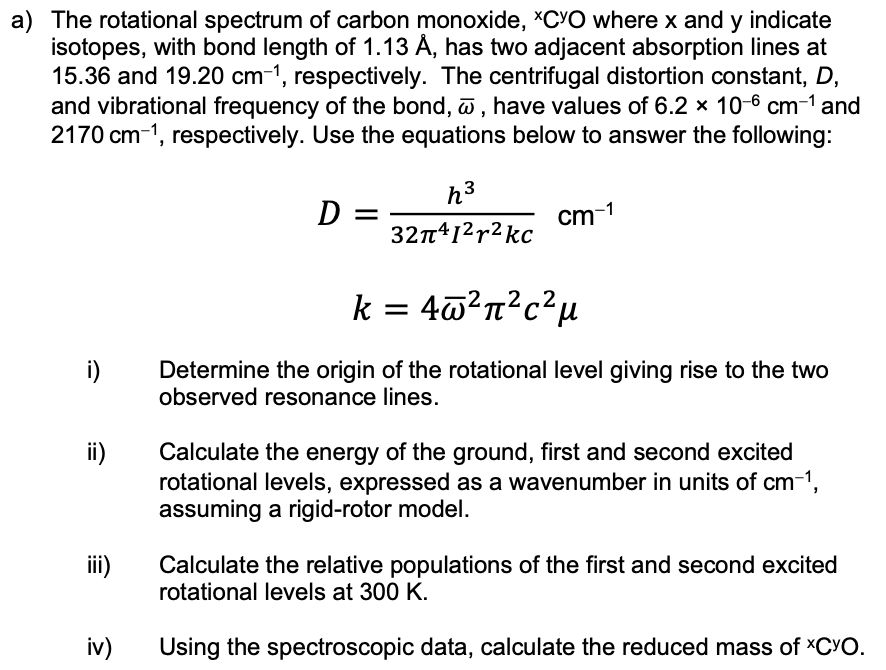i) Calculate the energy of the ground, first and second excited rotational levels, expressed as a wavenumber in units of cm-1, assuming a rigid-rotor model.
i) Calculate the energy of the ground, first and second excited rotational levels, expressed as a wavenumber in units of cm-1, assuming a rigid-rotor model.
Principles of Modern Chemistry
8th Edition
ISBN:9781305079113
Author:David W. Oxtoby, H. Pat Gillis, Laurie J. Butler
Publisher:David W. Oxtoby, H. Pat Gillis, Laurie J. Butler
Chapter20: Molecular Spectroscopy And Photochemistry
Section: Chapter Questions
Problem 9P
Related questions
Question
Please only answer part ii

Transcribed Image Text:a) The rotational spectrum of carbon monoxide, *CYO where x and y indicate
isotopes, with bond length of 1.13 Á, has two adjacent absorption lines at
15.36 and 19.20 cm-1, respectively. The centrifugal distortion constant, D,
and vibrational frequency of the bond, , have values of 6.2 × 10-6 cm-1 and
2170 cm-1, respectively. Use the equations below to answer the following:
h3
D :
cm-1
32n412r2 kc
k = 4@²n?c?µ
i)
Determine the origin of the rotational level giving rise to the two
observed resonance lines.
Calculate the energy of the ground, first and second excited
rotational levels, expressed as a wavenumber in units of cm-1,
assuming a rigid-rotor model.
ii)
ii)
Calculate the relative populations of the first and second excited
rotational levels at 300 K.
iv)
Using the spectroscopic data, calculate the reduced mass of XCYO.
Expert Solution
This question has been solved!
Explore an expertly crafted, step-by-step solution for a thorough understanding of key concepts.
Step by step
Solved in 2 steps with 2 images

Knowledge Booster
Learn more about
Need a deep-dive on the concept behind this application? Look no further. Learn more about this topic, chemistry and related others by exploring similar questions and additional content below.Recommended textbooks for you

Principles of Modern Chemistry
Chemistry
ISBN:
9781305079113
Author:
David W. Oxtoby, H. Pat Gillis, Laurie J. Butler
Publisher:
Cengage Learning

Physical Chemistry
Chemistry
ISBN:
9781133958437
Author:
Ball, David W. (david Warren), BAER, Tomas
Publisher:
Wadsworth Cengage Learning,


Principles of Modern Chemistry
Chemistry
ISBN:
9781305079113
Author:
David W. Oxtoby, H. Pat Gillis, Laurie J. Butler
Publisher:
Cengage Learning

Physical Chemistry
Chemistry
ISBN:
9781133958437
Author:
Ball, David W. (david Warren), BAER, Tomas
Publisher:
Wadsworth Cengage Learning,
